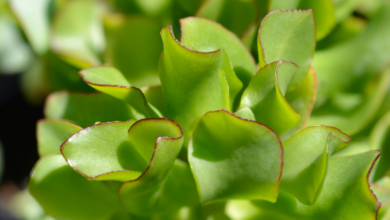This clump-forming herb is widely found in the African regions. It has an ornamental foliage pattern.
The irregularly spaced leaves have beautiful silver colors with deep green stripes.
You can easily identify it by observing its orange or red-colored petiole, also known as leaf stalk.
In addition, you will also notice its wavy margins on the leaves that are elliptic and elongated. This is how you can easily recognize this tropical plant.
This Chlorophytum plant should be placed in semi-shaded areas because direct sunlight can damage the leaves.
However, if you ever notice that the leaves are getting yellow or pale, it is a search sign of more light. In this condition, you may move them to a bright spot.
While planting it in a container, you should ensure that the container has several drainage holes.
To prepare an ideal soil mix, you should use organic and inorganic materials. This plant prefers moderate water.
They love temperatures between 60 and 75 degrees Fahrenheit. You can move them to a warm place to maintain the temperature correctly.
For maintaining humidity, you can use a humidifier or mist the leaves.
There is no need to fertilize them during the fall, but you should keep feeding them with liquid fertilizer from spring.
Chlorophytum Bichetii “Backer”
Like the other spider varieties, these species belong to the Asparagaceae family. You may also know it by another name – Saint Bernard’s Lily.
Chlorophytum bichetti “Backer” has a perennial lifespan with a shrubby shape.
This clump-forming herb has beautiful linear leaves with fascinating colors.
You will notice the combination of green and cream colors on the foliage. The center of the leaves is green, whereas the edge has a cream color.
These plants produce beautiful small white flowers that have six petals. You can grow them on the terrace as they suit the most on the terrariums.
However, you may also find these plants sold as aquarium plants. In this submerged condition, this species can survive up to 2 months.
People grow this spider plant mainly because of its ornamental foliage pattern.
If you plan to grow this species in your indoor garden, we suggest planting it in moist and well-drained soil.
It may even survive in infertile soil because of its hardiness.
You can either plant it in a hanging basket or a small container. Chlorophytum bichetti enjoys indirect light, and it grows at a moderate rate.
You can carefully plant the spiderettes (baby offshoots) in a small pot for propagation.
Make sure that the container has several drainage holes to remove excess moisture.
Chlorophytum Borivilianum
It has green leaves with a very narrow white colored border. The leaves and roots of this spider plant are considered white gold in India.
The edible roots are used for different therapeutic applications, such as curing physical illness, diabetes, boosting immunity, etc.
The roots are also an alternative medicine to Viagra as the plant has a spermatogenic attribute [2].
Growing Chlorophytum borivilianum is as easy as other plants. You only have to make sure that the soil is moist and well-drained.
They grow perfectly between the temperatures of 60 and 75 degrees Fahrenheit.
Humidity is an important factor that controls the beauty of their leaves.
You can also propagate this plant by separating the offsets from the mother plant.
It would be best to feed them with a balanced liquid fertilizer once every two weeks during the growing season.
Chlorophytum Capense
open next page to continue reading….




